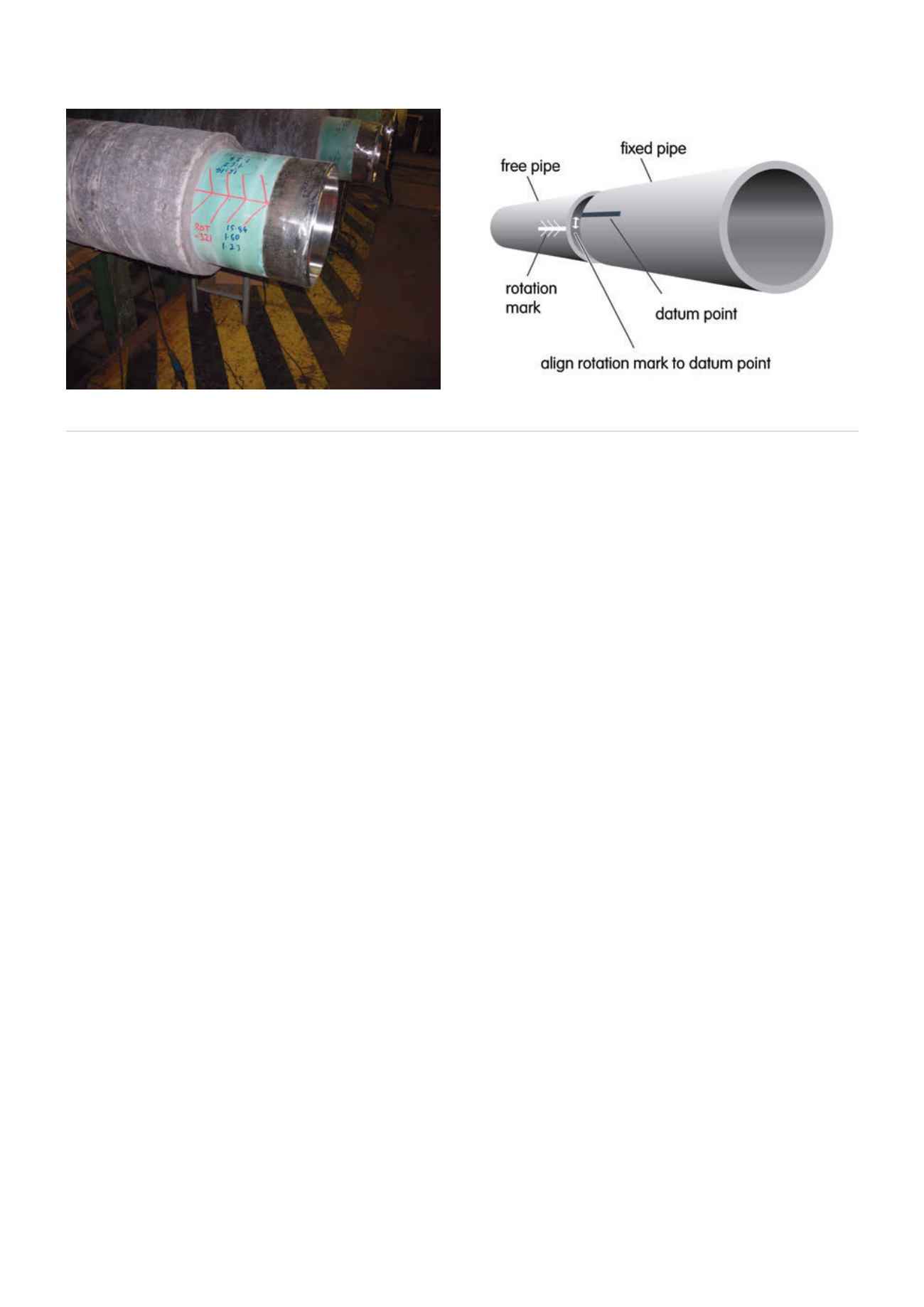
and fit-up in readiness for welding prior to pipelaying. Used
predominantly in the oil and gas industry, SmartFit ensures
accurate fit-up of pipes prior to welding and laying in
trenches, thus preventing environmentally damaging leaks.
In parallel, OMS has developed bespoke laser measuring
equipment and methodologies with supporting software,
for optimising pipe fit-up. The service reduces costs for
customers through faster pipelaying and improves quality by
eliminating misaligned pipe ends.
Measure, mark and fit-up
Each pipe end is measured, identified and entered into the
SmartFit software, which then analyses the fit-up of pipes,
allowing the operator to mark the best rotational position
on each pipe end. In the bead stall, these marks are aligned
to immediately achieve the best rotational position so that
misalignment is minimised and the project HiLo is easily
achieved.
Any problem pipes that will not fit at a specified HiLo are
also indicated, re-sequenced or removed completely, so that
fit-up problems do not occur in the bead stall. Production
delays due to misaligned pipes are avoided.
Experience shows that with typical flowline HiLo
requirements – and using typical seamless line pipe that has
not been counterbored – fit-up issues can occur regularly.
For a HiLo of around 1 - 1.2 mm, problems are likely to occur
every 10 - 20 pipes for flowline/seamless pipe. However, for
fatigue-sensitive pipes (i.e. in buckle zones), OMS can achieve a
HiLo of 0.05. Using SmartFit enables the required HiLo’s to be
achieved without trial and error. It also identifies problem pipe
in advance so that this can be removed from the pipe welding
sequence.
Project successes
OMS was contracted to perform pipe fit-up optimisation on
a project in Angola where the geometry of the pipes meant
that pipelay was running very slowly. The pipelay contractor
was concerned about whether the ‘worst’ pipes could be used
at all. SmartFit used measurements taken offshore and on the
pipelay barges to be applied aboard the pipelay vessel, from
which point the project was able to more than triple the rate
of pipe welding. Similar projects have occurred in Nigeria and
offshore from Sakhalin Island, Russia.
In addition to the optimisation of pipe fit-up, SmartFit
has also proved that it can also reduce the time it takes to
typically weld a joint, as well as reduce weld repair rates.
This was recognised by Petrobras when it published a short
paper at the Rio Oil & Gas 2011 conference, which confirmed
that on a recent project (GASPAL 1 & 2), OMS was able to
improve fit-up time by more than 40 seconds and reduce
repair rates by 7.8%.
More recently, OMS mobilised the Larson and Toubro
LTS3000
pipelay vessel in the Gulf of Martanan, Myanmar,
Burma. The client project team noted that with SmartFit,
fit-up was significantly improved, resulting in faster
alignment of the pipes prior to welding (3 min./weld). In
addition, no welds had to be repaired or redone. These
factors aboard the expensive, time critical pipelay path of
a pipelay vessel were considered significant for the client
during this short trial.
Even smarter software
OMS recently released a new version of SmartFit. In addition
to the sequencing of single pipe ends, the new software is
now capable of sequencing multiple pre-welded sections
of pipe (i.e. doubles, triples and quads), while also providing
improved visualisation of pipe fit-up and new, automated
reporting features.
The software was developed in response to the changing
needs of the oil and gas industry. The offshore oil and gas
market will increasingly require pipelay vessels that are
capable of installing large (more than 24 in.) diameter trunk
lines in all water depths, with more advanced dynamic
positioning capability.
Rather than weld single pipe ends, some of these
pipelaying vessels are now designed and equipped to carry
and/or weld multiple sections of pipe – in doubles, triples
or quads. Typically, these vessels carry pipe ends that have
either been pre-welded onshore into multiple sections, or
the vessels have facilities to weld the pipe ends onboard
Figure 4.
In the bead stall, the datum marks are aligned to immediately achieve the best rotational position so that misalignment is
minimised.
JULY 2015
/
World Pipelines
95


